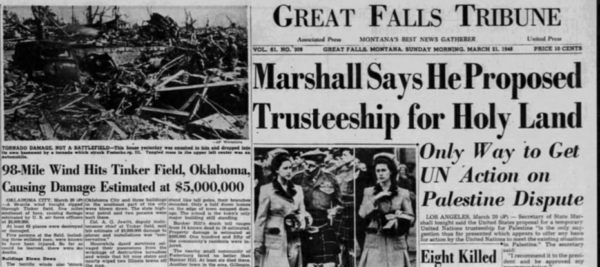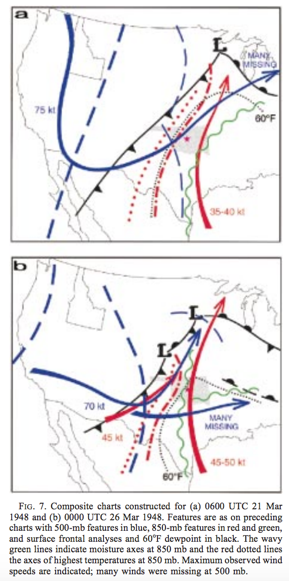The First Tornado Forecast

Headlines on the morning of Saturday, March 20, 1948 were dominated by the threat of communism. Secretary of State George Marshall struck a somber note as he spoke to students of the University of California, warning of the growing world crisis. He likened it to the rise of Hitler in 1932 Germany. A $6 billion foreign aid bill for Europe and China passed a critical hurdle in the House as the U.S. struggled to hold the line against communism. In Palestine, a Jewish republic was about to form.
Meanwhile, workers were digging out bodies and clearing rubble in the wake of an outbreak of tornadoes from Texas to New York. Nineteen people died when 80% of the town of Bunker Hill, Illinois was flattened. Nearby Fosterburg, Illinois recorded 13 fatalities.
At Tinker AFB in Oklahoma City, Captain Robert Miller was the forecaster on duty late that afternoon.
He and his backup forecaster analyzed the data and issued a forecast for gusty winds but no thunderstorms. Much to their surprise, lightning began to be reported to their west around 9 p.m. Their crude radar showed strong thunderstorms headed directly for their location. They hastily typed a warning for the base, but it was too late. Just seven miles to the west southwest, at Will Rogers Airpoirt, as the line of thunderstorms passed, winds gusted to 92 mph. In disbelief, they read the remark at the end of the report: TORNADO ON GROUND MOVING NE. They could only watch helplessly as a large tornado moved across the base, blowing the windows out of the control tower and causing millions of dollars in damage.
The next morning, an investigative team flew in from Washington. The forecasters and their boss, Major Ernest J. Fawbush, were grilled about the bad forecast. The investigators concluded that the storm could not have been forecast using existing techniques. But they recommended that base commanders work with their meteorologists to develop forecasting techniques to mitigate damage and casualties from severe storms.
Major Fawbush was ordered to work on such techniques. The next day, he and his team began poring over data and charts from previous events, including the March 20th Tinker AFB tornado. They came up with a series of weather parameters that had resulted in significant tornadoes.
On the morning of March 25, 1948, the meteorologists charted weather observations and created a prognostic charts for that evening. Major Fawbush and Colonel Miller looked at each other in amazement as they realized that the bullseye of a severe weather threat would exist across Central Oklahoma. The base commander was notified.
He looked at the data with the forecasters. Were they issuing a tornado forecast? Fawbush turned to Miller and stated, “It looks a lot like the 20th, doesn’t it?” The young Captain gulped and said that it did. The commanded stopped short of issuing a tornado forecast, but authorized a thunderstorm forecast. The new base warning plan was initiated and preparations were made.
The forecasters settled in for an uneasy wait to see if their forecast would verify. Storms began to show on the radr during the early afternoon. By extrapolation, the squall line was expected to reach the base by 6 p.m.
The commander returned to the weather office and asked again if the meteorologists were issuing a tornado forecast. They could only repeat their earlier observation, that the situations looked a lot like the one just five days earlier. The General barked that it seemed they should issue a tornado forecast if that were the case. Fawbush and Miller knew that such a forecast could get them laughed out of the Air Force. The orders were typed up at 2:50 p.m. and t he base’s new tornado plan went into action.
As the line of storms passed Will Rogers Airport, only wind gusts to 26 mph were reported. Captain Miller left, disgusted. After arriving home, a weather bulletin broke on the radio. He heard “destructive tornado” and “Tinker” and assumed the broadcaster was still talking about the tornado of five days ago. He tried to call the base weather office, but the lines were down. He excitedly drove back to the base and saw the destruction. Major Fawbush recounted the events as the reality of their successful forecast sunk in.
The tornado still caused $4 million in damage, but that was less than half of that caused by the earlier tornado. We know that the odds were astronomically low that a second tornado would hit the base five days later. With the good forecasting analysis had come a little luck, but the door was had been opened to successful tornado prediction. It would take over half a decade before tornado forecasts would become reality, but it was a a start.
Category: ALL POSTS, Met 101/Weather History



















